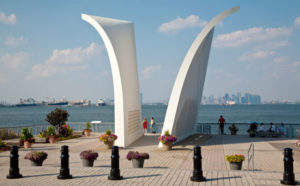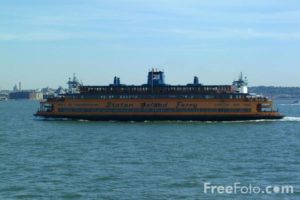
Recently, my Manhattan relatives took me on a tip over the bay to Staten Island so we could look at spots where our ancestors lived and where I spent my early childhood.
As we got off at the ferry terminal, it was evident that the northeast corner of the Island is undergoing a transformation. Construction cranes for a huge Northshore development project were very much in evidence. In 2018, the New York Wheel, similar to the London Eye, will be operational at one end of an expansive boardwalk. Already, a dramatic white structure, resembling two plane wings imbedded in the ground, stands as a memorial to those lost in 2001. (Note the World Trade Center was right across the water.) The new Lighthouse Museum is already open. High end shops will follow.
Often called New York City’s “forgotten borough” or the stepsister of Manhattan, the Bronx, Queens, and Brooklyn, the fourteen by seven mile piece of land is regaining its reputation as an escape to greenery and historical sites. Click on the map of sites from www.visitstatenisland.com, the official tourism office.
A century ago, before cars took the place of horses and ferries as the mode of transportation, Manhattanites escaped the summer heat of the Big Apple by coming to the small Victorian hotels that lined the hillside. That changed with the advent of cars and access to the Jersey Shore and the Poconos.

In St. George, the 83 acre grounds of the Snug Harbor Cultural Center has a major art gallery, a Chinese Scholar’s Garden based on the Ming Dynasty Garden (1368-1644) botanical garden, and an art lab. They offer a dual admission ticket with the Staten Island Children’s Museum: lots of exhibits and programs for kids one and older.
The Alice Austen House in Rosebank, an 18th century stle cottage overlooking the bay to Brooklyn, gives a sense of the architecture several centuries ago. Alice (1866-1952) was a legendary Islander, and well-known photographer who, sadly, died in the poorhouse at Seaview Hosptial. Her photos are at the Staten Island Historical Society on the grounds of Historic Richmondtown.
If you don’t consider burial grounds morose, the famous Moravian Cemetery contains the nationally known Vanderbilt Mausoleum. Cornelius Vanderbilt got his start on the Island by charging for sailboat rides from St. George to Manhattan. Though the Vanderbilts were known for their mansions on the Hudson and Newport, Rhode Island, the family had a sizable presence in the area for some time.
The Jacques Marchias Museum of Tibetan Art http://www.tibetanmuseum.org/ on Lighthouse Hill was designed by an Asian art expert so as to resemble a monastery with a garden, pond and rooms for reflection. It has regular meditaion Tai Chi programs, and claims to be one of the best museum of its type outside Tibet. When I was there visitors moved through slowly as if the surroundings put them in peaceful state.
Further south on the eastern shore Fort Wadsworth, a military installation whose origins datte back to the 1600s, still stands magestically and is open to the public. Make sure to drive on the coast to view beaches Cedar Grove, Great Kills Park, Gateway National Recreation The Area. Stroll in the sand, take a dip in season and enjoy the views across the water. Staten Islanders have been swimming here since tank woolen bathing suits were the rage.
Historic Richmondtown, https://www.historicrichmondtown.org/, a village and farm museum gives a glimpse of the Island when the center was agricultural. Houses and other colonial buildings have been moved here from other parts of the Island.
The Greenbelt Conservancy http://sigreenbelt.org is a 2,800 area of traditional and nature parks with many opportunities for boating and fishing, not to mention hiking trails.
At the southern tip of the Island, The Conference House, where Ben Franklin, John Adams, and Edward Rutledge met with the British Lord Howe on September 11, 1776, in an unsuccessful attempt to end the Revolutionary War. Dating back to 1680, and once the home of a prominent family, the Billops, it sits on the top of a hill looking over a bay full of small boats at the tip of the island. Those attending the conference took a short boat ride over to Perth Amboy on the New Jersey side. However, contemporary visitors can go north on Route 41 that goes directly back to the northern end of the Island and the ferry.
Route 41 has a history of its own. Back in the days when New York City’s trash was dumped into landfills on either side of the road, there was an outcry that the other boruoughs were using Staten Island as a repository for their trash. The highway is now lined with pristine undulating hills of green and is known as one of the best birding sites in the city.
St George has many restaurants, but Enteco Maria, next to the St. George Theater, has always gotten raves. Each night the food is cooked by a grandmother from a different culture.
